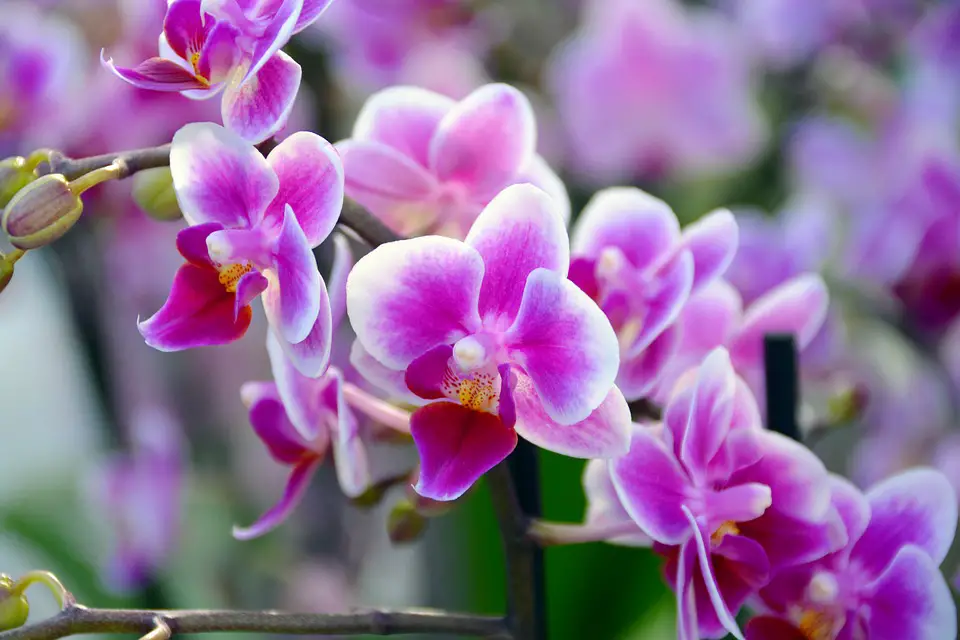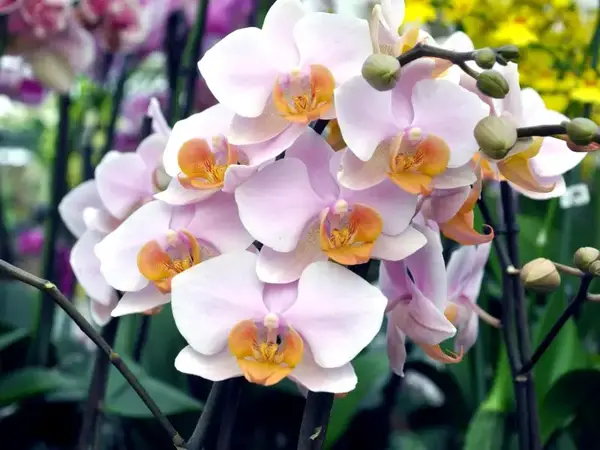
By purchasing such a beautiful, but very capricious plant like an orchid, every florist hopes that it will delight him with its long and beautiful flowering. For this, he is ready to indulge all his whims.
Well, when, how many times, and how often do phalaenopsis orchids bloom will be discussed in detail in this article.
How Often Do Phalaenopsis Orchids Bloom?
Often blooming orchids can bloom up to several times a year, provided that all the rules for their maintenance are followed. And of course, it depends on the type and age of the plant.
Do people also ask how often do phalaenopsis orchids bloom? A young orchid will not bloom at all and that’s fine. Because it must grow and get stronger, this process drains the flower very much and if it does not gain enough strength, it can die.
How many times in its life an orchid will bloom is difficult to say, because at any time a peduncle can begin to grow, and the flowering itself can last for several months over many years.
With the right care, an orchid can live for decades. Conversely, if your care is negligent, then it may not last up to five, and the flowering will be rare and not long.
What Determines The Flowering Time?
It is difficult to determine the timing of flowering of an orchid, because in the native environment, with a constant climate, this can happen at any time. At home, everything depends on several factors, such as:
- season;
- the length of daylight hours;
- plant variety;
- age.
This usually happens during the autumn-winter period. But there are species that throw out a peduncle in spring and summer.
And with the creation of certain conditions and rules of care, an orchid can generally bloom 2-3 times a year.
Attention! Flowers appear only in an adult plant. If you don’t know the age of an orchid, then it can be determined by the number of leaves. An adult should have 5-8.
When Does Orchids Blooming Period Begin?
Different varieties prefer their own season and it is not necessary that it will be summer when the plant blooms. The flowering period is individual for each type of plant:
- In phalaenopsis, paphidopellums, this period is considered winter – November-March.
- Cymbidiums and dendrobiums will delight from October to February, and with proper care, it can also be in summer.
- Cattleya blooms from spring to early winter.
- Oncidium – April-June.
- Miltassia and Miltonia bloom in spring or autumn.
But also experienced florists deceive the plants and create favorable conditions, achieving flowering in another period.
Here is a guide on Methods For Propagating Orchids From Aerial Roots. or if you want to Growing Phalaenopsis Orchids under Lights.
How Long Does It Take For An Orchid To Rebloom?

The orchid, as one of the most capricious plants, needs a period of adaptation in a new place. First you need to create favorable living conditions for her.
The first time an orchid can bloom in 1.5-3 years, ask the seller about its age. It is not necessary to stimulate a young plant for an earlier ejection of the peduncle, as this can lead to the death of the flower. To do this, he must gain strength, build a good root system, rich green foliage.
It is impossible to determine the exact timing of the first flowering, they are individual for each . Try to properly care for the plant, provide:
- comfortable and long-lasting lighting;
- air humidity;
- temperature regime.
Do not rearrange it, it is very sensitive to location changes. Under good conditions, it will not be slow to delight you with its beautiful flowers.
A faded orchid begins to actively vegetate, grow roots and greenery . When the plant has bloomed, the peduncle begins to dry out and turn black, it needs to be cut off, also during this period the flower can be transplanted, fertilized, help the better development of roots and leaves, and after 2-3 months the plant can bloom again.
If you orchid leaves are drying out here is answer Why Are My Orchid Leaves Cracking? Proper Care After Fixing
Some orchid species throw out the arrow immediately after the formation of a new leaf.
Also, the duration of the rest period is influenced by:
- Plant age.
- His health.
- View.
- Conditions of detention.
If you already see that the plant is healthy, looks good, has gained strength, but for some reason does not bloom, then you can push it a little. To do this, you can arrange for him a sharp temperature drop: it is cold at night and warm during the day. A difference of 8-10 degrees is quite enough, and the plant should not be watered. The procedure should take 2-3 weeks. After that, return it to its previous conditions and the result will not belong in coming.
What Is The Lifespan Of An Orchid?
The flowering time in most cases depends on the age of the plant, its type, and the comfort of the conditions. It can be from 2 to 6-8 months. It is believed that one flower on a stem lasts about 3-4 weeks, and the difference between the opening of the buds is a month or more.
Attention! Phalaenopsis belongs to the longest flowering variety. In adulthood, this plant can bloom all year round, throwing out new peduncles in turn.
Be sure to provide the plant with long-term illumination, at least 12 hours. Otherwise, it may discard colors.
Want to know about Phalaenopsis Stuartiana.
How Do You Keep Phalaenopsis Orchids Alive?
The orchid bloom is so beautiful and unique that every grower wants to prolong this pleasure. But how can you do this? Remember that every wrong action can cause the plant to shed flowers.
Caring for orchids during flowering consists of watering, it should be strengthened. It is advised to do this with a warm shower, imitating tropical rain. After such a procedure, do not forget to remove moisture from the growing point, in order to avoid decay.
The night temperature should be at least 18 degrees, and the difference from the daytime should be within 5-6.
Do not forget that the lighting should be at least 12 hours, illuminate with special lamps with short daylight hours. Lack of light at the orchid flowering stage leads to unpleasant consequences:
- wilting and drying of unblown buds;
- disclosure of flowers for a very short time;
- dropping them one by one.
Attention! Use phytolamps for supplementary lighting – they do not dry or overheat the air.
Also, the flower needs daily spraying and humidification. You can use special devices or put pallets with water. Ventilate the room, but do not leave the plant in a draft, it will not like it either.
The main thing at this time is the plant is not allowed:
- Rearrange.
- Overfeed.
- Transplant.
An orchid is a living organism that mirrors your actions. And the better its content, the more abundant and longer flowering. Love your plant and it will delight you for years to come.
